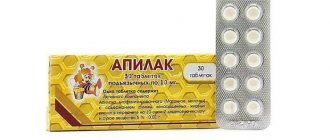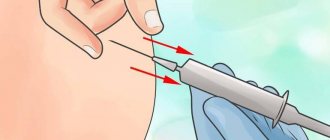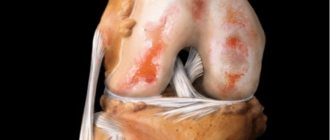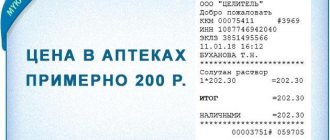What is potassium iodide
The microelement is described as a crystalline powder that has no distinct odor. The described substance (KI) is a salt of hydroiodic acid. Potassium iodide (Latin name Kalii iodidi) dissolves perfectly in liquid glycerin, alcohol and water. A drug based on inorganic iodine replenishes the microelement deficiency and restores the synthesis (incorrect connection process) of thyroid hormones. When taking the medicine while exposed to radiation, a protective effect occurs. Potassium iodide is an alternative to more expensive medications.
Composition and release form
The active substance of all forms of medication is potassium iodide. The medicine is sold in three modifications: solution, eye drops and tablets. Drops are available in 5-10 ml bottles. A 3% solution can be purchased in a 200 ml bottle (0.25-20% iodide). Film-coated tablets may contain the following dosage of the drug: 40, 100, 125, 200 mcg.
| Pills | Eye drops |
| 100 or 200 mcg iodide | 30 mg iodide |
| lactose | sodium thiosulfate |
| Aerosil | sodium chloride |
| magnesium carbonate | chlorhexidine diacetate |
| talc | sterile water |
| cellulose | |
| magnesium stearate |
Pharmacodynamics and pharmacokinetics
The drug has antiseptic properties, has mucolytic, absorbable, expectorant effects and has an antifungal effect. The medication is excreted by the kidneys and with the secretions of the sweat, salivary, bronchial, and mucous glands. Iodine ions penetrate into the epithelial cells of the thyroid gland and, under the action of enzymes, change into the chemical element I.
Under the influence of excess iodides, the biosynthesis of thyroid hormones and their release from thyroglobulin (protein) slow down. Secreted by the bronchial mucous glands, the medicine helps to thin the sputum. An important property of Potassium Iodide is to prevent the accumulation of radioactive isotopes in the thyroid gland and protect it from radiation. The drug quickly penetrates the digestive tract and is absorbed in the bronchial glands.
Indications for use
The drug in the form of drops is used for eye diseases: hemorrhages in the eye membranes, fungal infections of the conjunctiva, cornea and eyelid, as an element of auxiliary therapy for clouding of the vitreous body and lens, cataracts. Taking other forms of medication is indicated for xerostomia and inflammatory diseases of the salivary glands. Potassium iodide is used to prevent radioactive damage to the thyroid gland. Iodide has been proven effective in treating such ailments as erythema nodosum. Other indications for the use of iodine products are:
- thyrotoxic crisis;
- cutaneous-lymphatic sporotrichosis (a disease caused by filamentous fungi sporotrichum);
- prevention and treatment of endemic goiter;
- therapy of syphilis (tertiary period);
- bronchial asthma and fungal lung disease;
- treatment and prevention of goiter, relapse of the disease.
Analogs
Level 4 ATC code matches:
Blue Yod
Iodomarin
Analogues of Potassium iodide are other iodine-containing drugs: Iodomarin , Iodbalance , Iodine Vitrum , etc. The doctor must determine which drug is advisable to use during the treatment process.
Iodomarin or Potassium iodide: which is better?
Both drugs contain iodine and have a corresponding effect on the human body and, accordingly, the same indications for use. Only the excipients differ. In addition, Potassium iodide is a cheaper drug.
Potassium Iodide - instructions for use
The solution and tablets are taken orally after meals. To avoid irritation of the gastrointestinal tract, the required dose is washed down with milk, sweet tea, juice, jelly or water in large quantities. In ophthalmology, potassium eye drops are used in the form of a 3% solution. The liquid is instilled into the conjunctival sac for 10-15 days. Eye drops should be used three times a day. The course of treatment can be repeated. Iodide tablets are taken every day as long as there is a risk of radioactive iodine entering the body.
Pills
If necessary, the tablet can be crushed. As a preventative measure, adults are prescribed a dosage of 100-200 mcg per day. The course of treatment is prescribed by the doctor. In some cases, you need to take Iodide throughout your life. For hyperthyroidism, before surgery, the tablets are taken with water for 10 days, 250 mg per day. For the treatment of goiter, the dosage for adult patients is 200-600 mcg. If a relapse of the disease occurs, the drug is prescribed at a dose of 100-200 mcg per day.
Potassium Iodide solution
As a sputum thinner (mucolytic), a 1% or 3% solution of Potassium Iodide is prescribed, 3 tablespoons (0.3-1 g) 3 to 4 times a day. Patients with syphilis are prescribed 1 tbsp. l. three times a day after meals. The drug helps reduce pain and resolve seals. For the treatment of fungal lung disease (actinomycosis), larger doses are used - 1 tbsp. l. solution (10% or 20%) four times a day.
Indications for use
The product is used as an iodine preparation for the treatment of patients with hyperthyroidism (thyroid disease), with the development of endemic goiter (thyroid disease, which develops due to a reduced iodine content in water). It is also prescribed in preparation for surgical interventions in people with a severe form of thyrotoxicosis (a disease associated with increased function of the human thyroid gland). The medicine is prescribed to prevent radiation damage to the thyroid gland. It is used as an auxiliary drug in the treatment of syphilis .
Potassium iodide is also prescribed for the following diseases:
- inflammatory diseases of the respiratory tract;
- bronchial asthma.
Potassium iodide eye drops are prescribed for the following conditions:
- eye diseases (corneal clouding, cataracts , hemorrhages);
- fungal diseases of the cornea and conjunctiva.
Potassium Iodide for children
Children can take the medication if prescribed by a doctor. The daily dose of medication for adolescents, newborns and children is 50-200 mcg. For infants, the product is mixed with food. The course of treatment for goiter in newborns ranges from 2 to 4 weeks. For the prevention of endemic goiter and iodine deficiency, 100-200 mcg per day is recommended for adolescents from 12 years of age, and from 50 to 100 mcg per day for children under 12 years of age.
- How to bewitch your beloved guy at home
- How to deliciously cook mackerel in the oven - recipes with photos
- How to pickle mushrooms: recipes with photos
During pregnancy and lactation
During pregnancy, potassium iodide can only be used in the recommended dosage. Iodine is able to penetrate the placenta, so its excessive amount can provoke the development of goiter and hypothyroidism in the fetus. If you are pregnant, you should always consult your doctor before using this drug.
This element is also excreted in breast milk. Therefore, if a nursing mother uses the drug for treatment during breastfeeding, and the dose exceeds 1 mg per day, the baby may develop hypothyroidism.
Drug interactions
Excess potassium in the blood can be observed while taking iodine-containing drugs and potassium-sparing diuretics (diuretics). When lithium medications are used together, the development of goiter and hypothyroidism (lack of thyroid hormones) is observed. Iodide reduces the effects of antithyroid drugs (medicines that treat an overactive thyroid gland). The absorption of iodine by the thyroid gland is slowed down when taking potassium perchlorate (taken in a state of elevated levels of hormones of the endocrine organ).
Pharmacokinetics and pharmacodynamics
If the environment contains a normal amount of iodine, then under the influence of an excess amount of iodides, the process of biosynthesis of thyroid hormones is suspended, the level of sensitivity of the thyroid gland to the thyroid-stimulating hormone of the pituitary gland , and the production of thyroid-stimulating hormone by the pituitary gland is blocked.
After Potassium iodide is ingested, it is completely and quickly absorbed in the small intestine. Over the course of two hours, it is distributed inside the cells of the body. Accumulation occurs to a greater extent in the thyroid gland; iodide also accumulates in the mammary, salivary glands, and in the gastric mucosa. The substance penetrates the placenta.
It is excreted from the body through the kidneys, and about 80% of the drug dose is excreted within 48 hours, and the remaining part is excreted from the body in 10 to 20 days. Also, partial excretion occurs with secretions secreted by the salivary, bronchial, sweat and other glands.
Contraindications
Iodide is contraindicated in case of hypersensitivity to iodine-containing drugs, toxic adenoma, latent and severe hyperfunction (hyperthyroidism) of the thyroid gland, radioactive iodine therapy. Doctors do not prescribe a daily dosage of the drug higher than 1 mg for pregnant women and women during lactation. Potassium ions have a depressant effect on the heart, so the medication is contraindicated for heart disease, in which case it is better to take Sodium Iodide. Other contraindications include:
- dermatitis herpetiformis, Dühring's disease (skin lesions, blisters and blisters);
- acne;
- furunculosis;
- kidney disease (nephritis);
- pulmonary tuberculosis;
- diffuse goiter (only a small amount of iodine absorption is possible);
- thyroid cancer.
special instructions
Before starting a therapeutic course, you should undergo a complete examination of the visual system and thyroid gland
It is important to exclude any tumor-like growths and the presence of oncology
If a doctor has prescribed a medicine to patients with kidney disease, it is necessary to consult more often
It is important to monitor the level of potassium in the blood throughout the course of treatment. This also applies to those patients who are prescribed drugs that increase this substance, if for some reason they cannot stop using them
The medicine does not cause blurred vision, but it may cause other mild to severe side effects. If any negative manifestations appear, you should not drive a vehicle or operate machinery that requires fast psychomotor reactions.
Side effects
Taking a drug containing iodine can cause various disorders of the sensory organs (restlessness, anxiety), the nervous system (headache), and the gastrointestinal tract (diarrhea, nausea, gastralgia, vomiting, dyspeptic symptoms - general digestive disorders). The risk of allergic reactions, such as urticaria, angioedema, swelling of the salivary glands, hemorrhage on the skin and mucous membranes, cannot be excluded. Possible negative consequences of taking the drug with iodine:
- eosinophilia;
- hypothyroidism, hyperthyroidism (changes in thyroid function);
- exfoliative and other dermatitis;
- hyperkalemia;
- acne;
- redness of the conjunctiva;
- mumps (mumps);
- arthralgia (joint pain);
- iodine toxicity;
- fever;
- iodism;
- rhinitis;
- increased salivation;
- swelling of the eyelids;
- soreness of gums and teeth.
Why is iodine deficiency dangerous during pregnancy?
In addition to the fact that a lack of iodine in the diet causes unpleasant conditions (weakness, tachycardia, fatigue, nervousness, etc.) in the expectant mother, it can cause serious and irreparable harm to the fetus.
Severe iodine deficiency often causes spontaneous abortions and the birth of children with congenital developmental disorders (including deaf-muteness, strabismus, mental retardation and endemic neurological cretinism).
Even with a slight iodine deficiency, the level of thyroxine in the blood of a physically healthy pregnant woman decreases sharply (while when iodine is consumed in sufficient quantities, thyroxine remains within normal limits, decreasing by 12-15% by the time of birth), which can cause a number of complications during pregnancy and delivery - from spontaneous miscarriages and incoordination of labor to gestosis, premature birth and fetal asphyxia. To prevent the development of complications, a pregnant woman should consume at least 200 mcg of iodine during the day with food or in the form of various supplements.
Overdose
If the recommended dose is greatly exceeded, death is possible. It is necessary to strictly follow the instructions for use of the drug. Symptoms of acute overdose include: collapse, brown discoloration of the oral mucosa, anuria (lack of urine flow into the bladder), rhinitis, bleeding from the urinary tract, bronchitis, swelling of the vocal cords, gastroenteritis. Overdose is treated as follows:
- Gastric lavage with a solution of sodium thiosulfate (1%) and starch.
- Taking a thick broth (corn, oatmeal, rice or potato), porridge made from flour.
- Symptomatic and supportive therapy.
Potassium Iodide price
“Iodine replenisher” belongs to the category of inexpensive drugs. The price can vary from 60 to 161 rubles, depending on the place of sale, manufacturer, release form, delivery cost (if the purchase is made in an online pharmacy). The medicine is also sold in regular pharmacies in Moscow and the region. Below are the prices for Potassium Iodide in different online pharmacies:
| Pharmacy name | Release form of the medicine | Manufacturer | Cost, rubles |
| Europharm | 200 mcg 100 tablets | Ozon LLC | 110 |
| GorPharma | eye drops 3% 10 ml | S-PNII vaccines and serums | 165 |
| ZdravZone | 100 mcg 100 tab. | Obolenskoye FP | 60 |
| Alexandrovskaya Pharmacy | 100 mcg 100 tab. | Obolenskoye FP | 81 |
| Wer.ru | 200 mcg 112 tab. | Renewal | 80 |
| Chain of Moscow pharmacies IFK | 200 mcg 112 tab. | Update of CJSC PFK | 132 |
Description and composition
The drug "Potassium iodide" - eye drops. Reviews from doctors indicate that this medication is prescribed for vascular pathologies of the eyes and diseases of the cornea. The medicine contains the active ingredient potassium iodide. In addition to it, there are also additional components: chlorhexidine, sodium thiosulfate, sodium chloride and water. As they say about the drug "Potassium iodide" in reviews, drops are produced in convenient packaging. 10 milliliters of solution are placed in a bottle. For convenience, there is a measuring pipette. The medication can be stored for two years from the date of issue. But after opening the bottle, it must be used within 4 weeks. If you did not have time to complete the entire volume, then the remaining part should be thrown away. If the drug were sold in larger containers, it would be uneconomical. This is exactly what reviews say about the drug “Potassium Iodide”.
The price of eye drops ranges from 150 to 220 rubles. Costs may vary in different regions of the country. Statistics show that the average price tag for one bottle of medicine is approximately 168 rubles.










